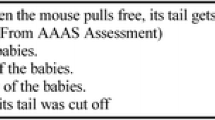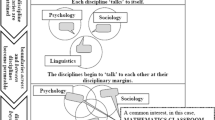Abstract
This study investigates Swedish biology teachers’ inclusion of proteins when teaching genetics in grade nine (students 15–16 years old). For some years, there has been a call to give attention to proteins when teaching genetics as a means of linking the concepts ‘gene’ and ‘trait’. Students are known to have problems with this relation because the concepts belong to different organizational levels. However, we know little about how the topic is taught and therefore this case study focuses on how teachers talk about proteins while teaching genetics and if they use proteins as a link between the micro and macro level. Four teachers were recorded during entire genetics teaching sequences, 45 lessons in total. The teachers’ verbal communication was then analyzed using thematic pattern analysis, which is based in systemic functional linguistics. The linguistic analysis of teachers’ talk in action revealed great variations in both the extent to which they used proteins in explanations of genetics and the ways they included proteins in linking genes and traits. Two of the teachers used protein as a link between gene and trait, while two did not. Three of the four teachers included instruction about protein synthesis. The common message from all teachers was that proteins are built, but none of the teachers talked about genes as exclusively encoding proteins. Our results suggest that students’ common lack of understanding of proteins as an intermediate link between gene and trait could be explained by limitations in the way the subject is taught.

Similar content being viewed by others
Notes
Of course, DNA does not exclusively code for amino acid sequences, but also for tRNA, rRNA, and regulatory sequences. However, for the level of education (introductory course in genetics at lower secondary school), we consider it reasonable to be excluded. So, for convenience, hereafter we regard DNA as encoding exclusively amino acids (in contrast to traits).
Melanin is actually not a protein, but a polymer constructed from the amino acid trypsin, catalyzed by the enzyme tyrosinase (protein). However, melanin is an intermediate that links the gene with the trait.
References
Allchin, D. (2000). Mending Mendelism. The American Biology Teacher, 62(9), 632–640.
Brown, B. A., & Spang, E. (2008). Double talk: synthesizing everyday and science language in the classroom. Science Education, 92(4), 708–732.
Dagher, Z., & Cossman, G. (1992). Verbal explanations given by science teachers: their nature and implications. Journal of Research in Science Teaching, 29(4), 361–374.
Darden, L. (2008). Thinking again about biological mechanisms. Philosophy of Science, 75(5), 958–969.
Donovan, J., & Venville, G. J. (2012). Blood and bones: the influence of the mass media on Australian primary school children’s understandings of genes and DNA. Science Education. doi:10.1007/s11191-012-9491-3.
dos Santos, V. C., Joaquim, L. M., & El-Hani, C. N. (2012). Hybrid deterministic views about genes in biology textbooks: a key problem in genetics teaching. Science Education, 21(4), 543–578.
Duncan, R. G. (2007). The role of domain specific knowledge in generative reasoning about complicated multileveled phenomena. Cognition and Instruction, 25(4), 271–336.
Duncan, R. G., & Reiser, B. J. (2007). Reasoning across ontologically distinct levels: studentst’ understandings of molecular genetics. Journal of Research in Science Teaching, 44(7), 938–959.
Duncan, R. G., Rogat, A. D., & Yarden, A. (2009). A learning progression for deepening students’ understanding of modern genetics across the 5th–10th grades. Journal of Research in Science Teaching, 46(6), 655–674.
Duncan, R. G., & Tseng, K. A. (2011). Designing project-based instruction to foster generative and mechanistic understandings in genetics. Science Education, 95(1), 21–56.
Eklund, J., Rogat, A.D., Alozie, N., & Krajcik, J.S. (2007). Promoting student scientific literacy of molecular genetics and genomics. Paper presented at the Annual Meeting of the National Association for Research in Science Teaching, April 2007, New Orleans
Fang, Z. (2005). Scientific literacy: a systemic functional linguistics perspective. Science Education, 89(2), 335–347.
Flodin, V. (2009). The necessity of making visible concepts with multiple meanings in science education: the use of gene concept in a biology textbook. Science Education, 18(1), 73–94.
Gericke, N. M., & Hagberg, M. (2007). Definition of historical models of gene function and their relation to students’ understanding of genetics. Science & Education, 16(7–8), 849–881.
Gericke, N. M., & Hagberg, M. (2010a). Conceptual incoherence as a result of the use of multiple historical models in school textbooks. Research in Science Education, 40(4), 605–623.
Gericke, N. M., & Hagberg, M. (2010b). Conceptual variation in the depiction of gene function in upper secondary school textbooks. Science & Education, 19(10), 963–994.
Gericke, N. M., Hagberg, M., & Jorde, D. (2013). Upper secondary students’ understanding of the use of multiple models in biology textbooks—The importance of conceptual variation and incommensurability. Research in Science Education, 43(2), 755–780.
Gericke, N. M., Hagberg, M., Santos, V. C., Joaquim, L. M., & El-Hani, C.N. (2012). Conceptual variation or incoherence? Textbook discourse on genes in six countries. Science & Education, doi: 10.1007/s11191-012-9499-8
Gericke, N. M. & Wahlberg, S. (2013). Clusters of concepts in molecular genetics: a study of Swedish upper secondary science students’ understanding. Journal of Biological Education, 47(2), 73–83.
Guilfoile, P. (1997). Wrinkled peas and white-eyed fruit flies: the molecular basis of two classical genetic traits. The American Biology Teacher, 59(2), 92–95.
Halliday, M. A. K. (1993). Towards a language-based theory of learning. Linguistics and Education, 5(2), 93–116.
Halliday, M. A. K., & Martin, J. R. (1993). Writing science: literacy and discursive power. Bristol: Falmer.
Halliday, M. A. K., & Matthiessen, C. M. I. M. (2004). An introduction to functional grammar. London: Arnold.
Hand, B., Alvermann, D., Gee, J., Guzzetti, B., Norris, S., Phillips, L., et al. (2003). Message from the “Island Group”: what is literacy in science literacy? Journal of Research in Science Teaching, 40(7), 607–615.
Knippels, M.C.P.J. (2002). Coping with the abstract and complex nature of genetics in biology education—the yo-yo learning and teaching strategy. Dissertation, CD-β Press, Utrecht.
Lemke, J. L. (1990). Talking science: language, learning, and values. Norwood: Ablex.
Lewis, J., Leach, J., & Wood-Robinson, C. (2000). All in the genes? Young people's understanding of the nature of genes. Journal of Biological Education, 34(2), 74–79.
Lewis, J., & Kattmann, U. (2004). Traits, genes, particles and information: re-visiting students’ understandings of genetics. Research report. International Journal of Science Education, 26(2), 195–206.
Machamer, P., Darden, L., & Craver, C. F. (2000). Thinking about mechanisms. Philosophy of Science, 67, 1–25.
Marbach-Ad, G. (2001). Attempting to break the code in student comprehension of genetic concepts. Journal of Biological Education, 35(4), 183–189.
Marbach-Ad, G., & Stavy, R. (2000). Students’ cellular and molecular explanations of genetic phenomena. Journal of Biological Education, 34(4), 200–205.
Mortimer, E. F., & Scott, P. (2003). Meaning making in secondary science classrooms. Buckingham: Open University Press.
Nygård-Larsson, P. (2008). Hur systematisk är systematiken? Några semiotiska resursers betydelse för skapandet av explicita tematiska mönster i lärartext och lärobok. In P. Juvonen (Ed.), Language and learning. Papers from the ASLA Symposium in Stockholm, 7–8 November (pp. 71–83). Uppsala: Svenska föreningen för tillämpad språkvetenskap.
Ogborn, J., Kress, G., Martins, I., & Mc Gillicuddy, K. (1996). Explaining science in the classroom. Buckingham: Open University Press.
Oyoo, S.O. (2011). Language in science classrooms: an analysis of physics teachers’ use of and beliefs about language. Research in Science Education. doi:10.1007/s11165-011-9228-3
Robson, C. (2002). Real world research: a resource for social scientists and practitioner-researchers. Oxford: Blackwell.
Schönborn, K. J., & Bögeholtz, S. (2009). Knowledge transfer in biology and translation across external representations: experts’ views and challenges for learning. International Journal of Science and Mathematics Education, 7(5), 931–955.
Swedish National Agency for Education. (2006). Curriculum for the compulsory school system, the pre-school class and the leisure-time centre (94th ed.). Stockholm: Swedish National Agency for Education.
Swedish National Agency for Education. (2011). Curriculum for the compulsory school system, the pre-school class and the leisure-time centre 2011. Stockholm: Swedish National Agency for Education.
Tsui, C.-Y., & Treagust, D. F. (2007). Understanding genetics: analysis of secondary students’ conceptual status. Journal of Research in Science Teaching, 44(2), 205–235.
van Mil, M., Boerwinkel, D., & Waarlo, A. (2013). Modelling molecular mechanisms: a framework of scientific reasoning to construct molecular-level explanations for cellular behaviour. Science & Education 22(1), 93–118
Venville, G. J., & Donovan, J. (2005). Searching for clarity to teach the complexity of the gene concept. Teaching Science, 51(3), 20–24.
Venville, G. J., Gribble, S. J., & Donovan, J. (2005). An exploration of young children’s understandings of genetics concepts from ontological and epistemological perspectives. Science Education, 89(4), 614–633.
Venville, G. J., & Treagust, D. F. (1998). Exploring conceptual change in genetics using a multidimensional interpretive framework. Journal of Research in Science Teaching, 35(9), 1031–1055.
Venville, G. J., & Treagust, D. F. (2002). Teaching about the gene in the genetic information age. Australian Science Teachers Journal, 48(2), 20–24.
Verhoeff, R. P., Boerwinkel, D. J., & Waarlo, A. J. (2009). Genomics in school. EMBO Reports, 10(2), 120–124.
Wellington, J., & Osborne, J. (2001). Language and literacy in science education. Buckingham: Open University Press.
Wilson, J. M. (1999). Using words about thinking: content analyses of chemistry teachers’ classroom talk. International Journal of Science Education, 21(10), 1067–1084.
Acknowledgments
We would like to thank The Hasselblad Foundation for financing this research. We would also like to thank the teachers and students who participated in the study.
Author information
Authors and Affiliations
Corresponding author
Rights and permissions
About this article
Cite this article
Thörne, K., Gericke, N. Teaching Genetics in Secondary Classrooms: a Linguistic Analysis of Teachers’ Talk About Proteins. Res Sci Educ 44, 81–108 (2014). https://doi.org/10.1007/s11165-013-9375-9
Published:
Issue Date:
DOI: https://doi.org/10.1007/s11165-013-9375-9




